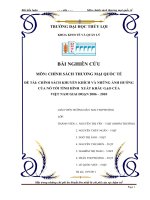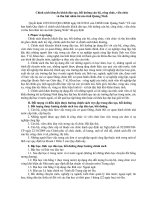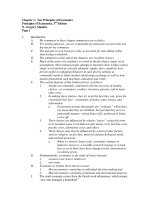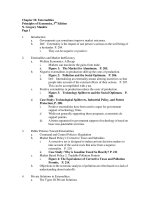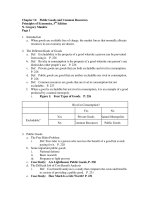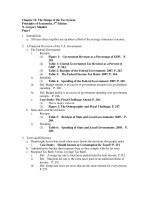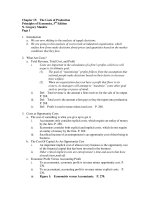Sách khuyến khích đọc - kinhtevimo M11
Bạn đang xem bản rút gọn của tài liệu. Xem và tải ngay bản đầy đủ của tài liệu tại đây (81.03 KB, 2 trang )
Chapter 11: Public Goods and Common Resources
Principles of Economics, 5th Edition
N. Gregory Mankiw
Page 1
1. Introduction
a. When goods are available free of charge, the market forces that normally allocate
resources in our economy are absent.
2. The Different Kinds of Goods
a. Def: Excludability is the property of a good whereby a person can be prevented
from using it. P. 226
b. Def: Rivalry in consumption is the property of a good whereby one person’s use
diminishes other people’s use. P. 226
c. Def: Private goods are goods that are both excludable and rival in consumption.
P. 226
d. Def: Public goods are good that are neither excludable nor rival in consumption.
P. 226
e. Def: Common resources are goods that are rival in consumption but not
excludable. P. 227
f. When a good is excludable but not rival in consumption, it is an example of a good
produced by a natural monopoly.
i.
Figure 1: Four Types of Goods. P. 226
Rival in Consumption?
Excludable?
Yes
No
Yes
Private Goods
Natural Monopolies
No
Common Resources
Public Goods
3. Public Goods
a. The Free Rider Problem
i.
Def: Free rider is a person who receives the benefit of a good but avoids
paying for it. P. 228
b. Some important public goods
i.
National defense
ii.
Basic research
iii.
Programs to fight poverty
c. Case Study: Are Lighthouses Public Goods, P. 230
d. The Difficult Job of Cost Benefit Analysis
i.
Def: Cost benefit analysis is a study that compares the costs and benefits
to society of providing a public good. P. 231
e. Case Study: How Much Is a Life Worth? P. 231
Chapter 11: Public Goods and Common Resources
Principles of Economics, 5th Edition
N. Gregory Mankiw
Page 2
4. Common Resources
a. Def: The tragedy of the commons is a parable that illustrates why common
resources get used more than is desirable from the standpoint of society as a whole.
P. 232
i.
It arises because of externalities.
b. Some important common resources:
i. Clean air and water
ii. Congested roads and
iii. Fish, whales, and other wildlife
c. In the News: The Bloomberg Plan, P. 234.
d. Case Study: Why the Cow Is Not Extinct, P. 236
5. Conclusion: The Importance of Property Rights
a. In all cases, the market fails to allocate resources efficiently because property rights
are not well established.
6. Summary

